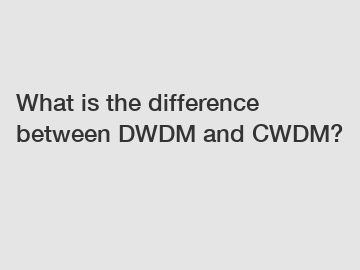What is the difference between DWDM and CWDM?
Data transmission has revolutionized the way we communicate and access information in today's digital age. With the increasing demand for high-speed internet and uninterrupted connectivity, advanced technologies such as Dense Wavelength Division Multiplexing (DWDM) and Coarse Wavelength Division Multiplexing (CWDM) have emerged to meet the growing needs of data transmission. While both DWDM and CWDM serve the same fundamental purpose of transmitting multiple data signals over a single fiber optic cable, there are significant differences between the two technologies that set them apart.
DWDM, as the name suggests, utilizes a dense arrangement of wavelengths to transmit data signals over a single fiber optic cable. This technology can support hundreds or even thousands of wavelengths, each carrying a unique data signal. By assigning different wavelengths to each data signal, DWDM enables high-capacity data transmission with minimal interference between signals. This allows for greater bandwidth efficiency and higher data transfer speeds, making DWDM ideal for long-haul transmission and high-capacity networks.
On the other hand, CWDM uses a wider spacing of wavelengths compared to DWDM. While DWDM typically operates in the C-band and L-band wavelength ranges, CWDM operates in the wider spectrum of wavelengths ranging from 1270nm to 1610nm. This wider wavelength spacing allows for a lower number of wavelengths to be transmitted simultaneously compared to DWDM. As a result, CWDM is better suited for shorter-distance transmission and networks with lower bandwidth requirements.

One of the key differences between DWDM and CWDM lies in their respective channel spacing. DWDM typically operates with channel spacings of 0.8nm or even smaller, allowing for a higher number of channels to be transmitted over a single fiber optic cable. In contrast, CWDM operates with larger channel spacings of around 20nm, resulting in fewer channels being transmitted simultaneously. While DWDM offers greater scalability and flexibility in terms of channel spacing, CWDM provides a more cost-effective solution for networks with lower bandwidth requirements.
Another important difference between DWDM and CWDM is their respective spectral efficiency. DWDM offers higher spectral efficiency compared to CWDM, allowing for more data signals to be transmitted over a given bandwidth. This results in higher data transfer speeds and increased capacity for data transmission. In contrast, CWDM offers lower spectral efficiency due to its wider wavelength spacing, limiting the number of data signals that can be transmitted simultaneously. While CWDM may be sufficient for networks with lower bandwidth requirements, DWDM is the preferred choice for high-capacity networks that require maximum spectral efficiency.
In terms of cost, CWDM is generally more cost-effective than DWDM due to its simpler architecture and lower hardware requirements. CWDM requires fewer components and is easier to deploy, making it an attractive option for networks with budget constraints. However, DWDM's higher initial investment can be justified by its superior performance and scalability, making it a preferred choice for high-capacity and long-haul networks.
While DWDM and CWDM serve different needs and have unique advantages and disadvantages, both technologies play a crucial role in enabling high-speed data transmission over fiber optic networks. Whether you require high-capacity transmission for long-haul networks or cost-effective solutions for shorter-distance networks, choosing the right technology will depend on your specific requirements and budget constraints.
In conclusion, the key differences between DWDM and CWDM lie in their channel spacing, spectral efficiency, scalability, and cost. While DWDM offers higher spectral efficiency, scalability, and performance, CWDM provides a more cost-effective solution for networks with lower bandwidth requirements. By understanding the differences between these two technologies, network operators can make informed decisions when choosing the right technology to meet their data transmission needs.
For more Fence Sensors, RF970 fiber optic fence security system, Precise Positioning Type Fiber Intrusion Detection Systeminformation, please contact us. We will provide professional answers.

Comments
0